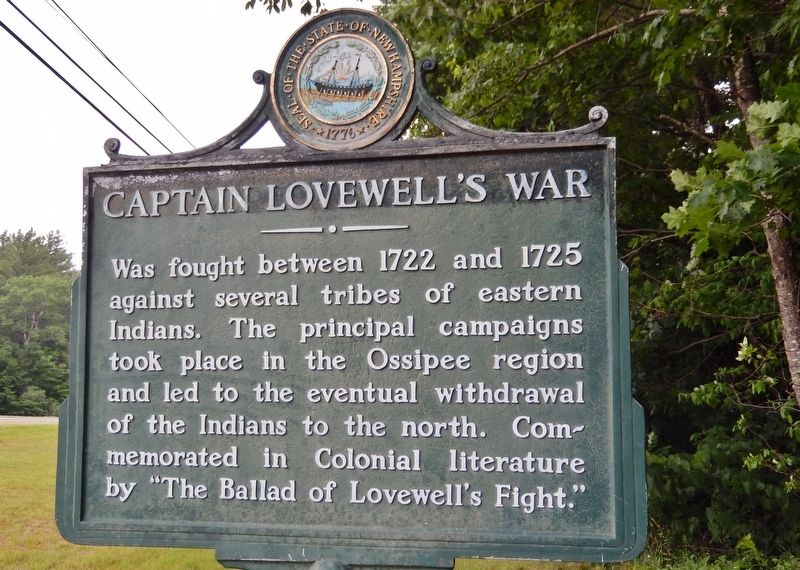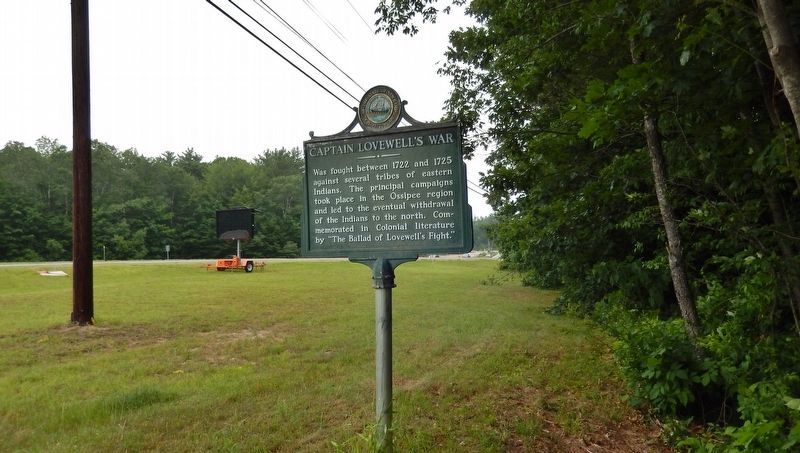Center Ossipee in Carroll County, New Hampshire — The American Northeast (New England)
Captain Lovewell's War
Was fought between 1722 and 1725 against several tribes of eastern Indians. The principal campaigns took place in the Ossipee region and led to the eventual withdrawal of the Indians to the north. Commemorated in Colonial literature by “The Ballad of Lovewell's Fight.”
Erected 1965 by State of New Hampshire. (Marker Number 20.)
Topics. This historical marker is listed in these topic lists: Arts, Letters, Music • Colonial Era • Native Americans • Wars, US Indian. A significant historical year for this entry is 1722.
Location. 43° 46.55′ N, 71° 9.791′ W. Marker is in Ossipee, New Hampshire, in Carroll County. It is in Center Ossipee. Marker is at the intersection of White Mountain Highway (New Hampshire Route 16) and New Hampshire Route 16B, on the right when traveling north on White Mountain Highway. Touch for map. Marker is in this post office area: Ossipee NH 03864, United States of America. Touch for directions.
Other nearby markers. At least 8 other markers are within 13 miles of this marker, measured as the crow flies. First Summer Playhouse (approx. 7.6 miles away); In Memory of Those Who Served (approx. 7.6 miles away); Granville Homestead (approx. 8.6 miles away); The Grave By The Lake (approx. 9.3 miles away); Abenaki Tower (approx. 9.7 miles away); The Chocorua Legend (approx. 9.9 miles away); College Road (approx. 12.1 miles away); Chinook Kennels (approx. 12.3 miles away).
Also see . . .
1. Lovewell’s War – Indian Wars. Access Genealogy website entry:
The contest between the New England colonists and the Indians, which begun in 1722, and concluded in 1725, was called “Lovewell’s War,” from Captain John Lovewell, of Dunstable, being the principal English commander engaged in it. Although the English had purchased the greater portion of the land they occupied, the Indians, instigated by the French, would not acknowledge their title. Nothing would satisfy the Indians but a complete settlement of the boundaries. This the English governor, Shute, refused to effect, and the parties left the conferences with embittered feelings... (Submitted on June 29, 2020, by Cosmos Mariner of Cape Canaveral, Florida.)
2. The Story of Lovewell's Fight. American History and Genealogy Project website entry:
John Lovewell and other men asked permission to form a company of rangers to hunt and kill Indians. The Legislature of Massachusetts granted their request and agreed to pay them one hundred pounds or $500 in our money, for every Indian whose scalp they brought home. John Lovewell was made captain of the rangers. Their uniform
was like that of woodsmen, and each was armed with a firelock and a hatchet, carrying under his right arm a powder horn, and at his waist a leather bag for bullets. To each officer was given a pocket compass. (Submitted on June 29, 2020, by Cosmos Mariner of Cape Canaveral, Florida.)
3. A Slice of Lovewell History. Lovewell History website entry:
Decades before anyone had heard of Robert Rogers or Daniel Boone, Captain John Lovewell may have been the most famous Indian fighter in North America. In 1724, Captain John decided to put an end to the recurring raids that ravaged the English settlements near Dunstable. Raising a company of rangers, known as "snowshoe men," he took the fight to the enemy. After two successful forays into the northern frontier, his career and his life came to an end in May of 1725 when Abenakis ambushed his company at Saco Pond, later renamed Lovewell Pond. After "Lovewell's Fight," only about half of the captain's men found their way home again, but the Abenakis had also taken heavy casualties and were forced to make peace. (Submitted on June 29, 2020, by Cosmos Mariner of Cape Canaveral, Florida.)
4. The Ballad of Lovewell's Fight. (A Popular Ballad. Written shortly after the Battle of May 8th, 1725.)
Of worthy Captain LOVEWELL, I purpose now to sing,
How valiantly he served his country and his King;
He and his valiant soldiers did range the woods full wide,
And hardships they endured to quell the Indian's pride. (Submitted on June 29, 2020, by Cosmos Mariner of Cape Canaveral, Florida.)
Credits. This page was last revised on February 16, 2023. It was originally submitted on June 28, 2020, by Cosmos Mariner of Cape Canaveral, Florida. This page has been viewed 673 times since then and 63 times this year. Photos: 1, 2. submitted on June 28, 2020, by Cosmos Mariner of Cape Canaveral, Florida.

